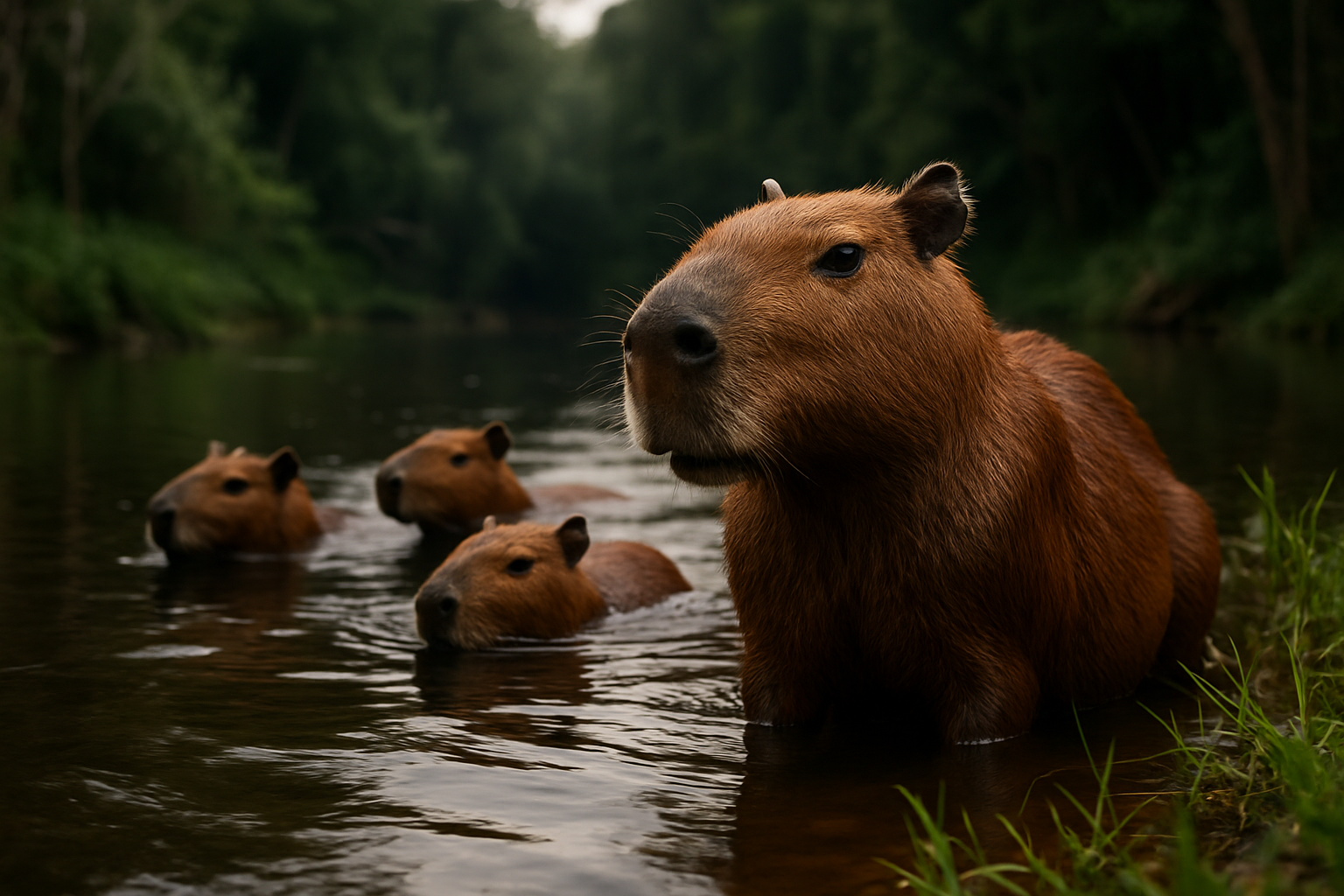Unveiling the Secret Life of Capybaras: Nature's Gentle Giants
In the lush landscapes of South America, a unique and captivating creature roams the wetlands and grasslands: the capybara. These oversized rodents, often mistaken for giant guinea pigs, have captured the hearts of animal enthusiasts worldwide. But beneath their adorable exterior lies a fascinating world of social behavior, evolutionary adaptations, and unexpected ecological importance. Join us as we dive into the secret life of capybaras, exploring their remarkable characteristics and the growing trend of capybara-themed tourism.

The Evolutionary Marvel of Capybaras
Capybaras have a rich evolutionary history that dates back millions of years. These unique rodents descended from a group of South American rodents that diverged from other rodent lineages around 35 million years ago. Over time, they adapted to fill a niche as large, semi-aquatic herbivores, developing several remarkable features that set them apart from their rodent relatives.
One of the most striking adaptations of capybaras is their teeth. Like all rodents, their incisors grow continuously throughout their lives. However, capybaras have evolved specially adapted molars that are perfect for grinding tough vegetation. These teeth have deep roots and high crowns, allowing them to withstand the wear and tear of a herbivorous diet in often gritty, sandy environments.
Another fascinating evolutionary trait is their webbed feet. While not as pronounced as those of ducks or otters, the partial webbing between their toes provides excellent propulsion in water, making capybaras skilled swimmers. This adaptation, combined with their ability to hold their breath for up to five minutes, allows them to escape predators by diving underwater and traveling long distances beneath the surface.
Social Butterflies of the Animal Kingdom
Contrary to the solitary nature of many rodents, capybaras are highly social animals. They live in groups ranging from 10 to 40 individuals, with some reports of herds numbering up to 100 during the dry season when resources are scarce. These social structures are not just for safety in numbers; they play a crucial role in capybara wellbeing and reproduction.
Within these groups, capybaras exhibit complex social behaviors. They communicate through a variety of vocalizations, including barks, whistles, and purrs. These sounds serve different purposes, from warning calls to mating rituals. Capybaras also engage in social grooming, which helps to strengthen bonds within the group and maintain hygiene.
Perhaps most intriguingly, capybaras practice a form of communal care for their young. Females often nurse each other’s pups, a behavior known as alloparental care. This cooperative breeding strategy ensures that young capybaras have the best chance of survival, even if their mother is unable to provide adequate care.
Ecological Importance and Conservation Challenges
While capybaras may seem like gentle giants with little impact on their environment, they play a crucial role in maintaining the ecological balance of their habitats. As herbivores, they help to control plant growth in wetland areas, preventing overgrowth and maintaining biodiversity. Their grazing habits also create pathways through dense vegetation, benefiting smaller animals that use these trails.
Moreover, capybaras serve as a food source for many predators, including jaguars, caimans, and anacondas. Their presence in an ecosystem supports the survival of these apex predators, contributing to the overall health of the food web.
Despite their ecological importance, capybaras face several conservation challenges. Habitat loss due to agricultural expansion and urban development is a significant threat to capybara populations in some areas. Additionally, in some regions, they are hunted for their meat and leather, leading to local population declines.
Conservation efforts are underway to protect capybara habitats and promote sustainable management practices. In some countries, such as Venezuela and Colombia, capybaras are farmed for their meat, which, when done sustainably, can reduce pressure on wild populations while providing economic benefits to local communities.
The Rise of Capybara Tourism
In recent years, there has been a growing trend of capybara-themed tourism, particularly in Japan and parts of South America. This phenomenon has brought these charismatic creatures into the spotlight and offers a unique opportunity for conservation education.
In Japan, several hot spring resorts have become famous for their resident capybaras. During the winter months, these facilities provide warm baths for capybaras, mimicking the hot springs they might seek out in the wild. This practice, known as “capybara onsen,” has become a major tourist attraction, with visitors flocking to see these adorable animals relaxing in steaming pools.
The popularity of capybara tourism has led to the development of capybara-themed merchandise, from plush toys to clothing and accessories. While the commercialization of wildlife can be controversial, it has also raised awareness about these animals and their conservation needs.
In South America, eco-tourism operations are offering visitors the chance to observe capybaras in their natural habitats. These tours not only provide economic incentives for habitat conservation but also educate visitors about the importance of wetland ecosystems and the animals that inhabit them.
The Future of Capybara Research and Conservation
As interest in capybaras grows, so does the field of capybara research. Scientists are continually uncovering new aspects of capybara biology, behavior, and ecology. Recent studies have focused on their role in ecosystem services, such as seed dispersal and nutrient cycling in wetland environments.
One area of particular interest is the capybara’s unique digestive system. Like many herbivores, capybaras practice coprophagy – the consumption of their own feces. This behavior allows them to extract maximum nutrition from their plant-based diet. Researchers are studying this process to better understand gut microbiomes and potentially develop new probiotics for livestock and even humans.
As climate change continues to alter habitats worldwide, scientists are also investigating how capybaras might adapt to changing environmental conditions. Their semi-aquatic lifestyle and ability to thrive in various habitats may make them more resilient than some species, but long-term studies are needed to fully understand the potential impacts.
In conclusion, capybaras represent a fascinating intersection of evolutionary biology, social behavior, and ecological importance. As we continue to unravel the secrets of these gentle giants, we gain not only a deeper appreciation for the complexity of the natural world but also valuable insights that may help us address broader environmental challenges. Whether you encounter them in the wild, at a hot spring resort, or through conservation education programs, capybaras serve as charismatic ambassadors for the importance of biodiversity and habitat preservation in our rapidly changing world.





